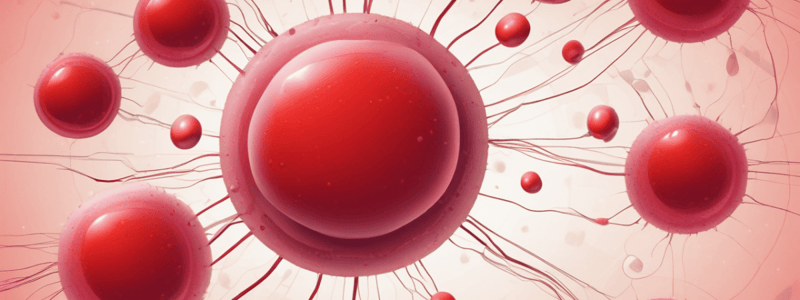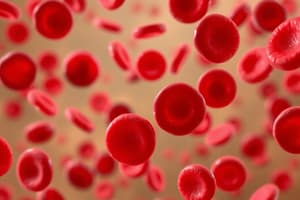Podcast
Questions and Answers
What is the normal haematocrit value for females?
What is the normal haematocrit value for females?
35-45%
What is the function of haemoglobin in RBCs?
What is the function of haemoglobin in RBCs?
Carries oxygen to tissues
What is the normal value of haemoglobin in males?
What is the normal value of haemoglobin in males?
130-160g/L
What is the main cause of elevated haematocrit?
What is the main cause of elevated haematocrit?
What is the normal value of platelet count?
What is the normal value of platelet count?
What is the production site of lymphocytes?
What is the production site of lymphocytes?
What is the cause of anaemia due to destruction of RBCs?
What is the cause of anaemia due to destruction of RBCs?
What is the hormone that stimulates RBC production?
What is the hormone that stimulates RBC production?
What are the three roles of platelets during the initial response to injury?
What are the three roles of platelets during the initial response to injury?
What is Prothrombin Time (PT) and what does it measure?
What is Prothrombin Time (PT) and what does it measure?
What is the normal range for calcium levels in the blood?
What is the normal range for calcium levels in the blood?
What is the function of potassium in the body?
What is the function of potassium in the body?
What is the normal range for Creatinine Kinase (CK) levels?
What is the normal range for Creatinine Kinase (CK) levels?
What is the function of Alanine Amino Transferase (ALT) in the liver?
What is the function of Alanine Amino Transferase (ALT) in the liver?
What is the normal range for Alkaline Phosphatase (ALP) levels?
What is the normal range for Alkaline Phosphatase (ALP) levels?
What is the function of Bilirubin in the body?
What is the function of Bilirubin in the body?
What is the normal range for Albumin levels?
What is the normal range for Albumin levels?
What is the function of the International Normalised Ratio (INR) in measuring clotting ability?
What is the function of the International Normalised Ratio (INR) in measuring clotting ability?
What is the primary function of platelets in the initial response to injury?
What is the primary function of platelets in the initial response to injury?
What does Prothrombin Time (PT) measure?
What does Prothrombin Time (PT) measure?
What is the function of calcium in the body?
What is the function of calcium in the body?
What is the function of potassium in the body?
What is the function of potassium in the body?
What is the function of Creatinine Kinase (CK)?
What is the function of Creatinine Kinase (CK)?
What is the function of Alanine Amino Transferase (ALT) in the liver?
What is the function of Alanine Amino Transferase (ALT) in the liver?
What is the function of Alkaline Phosphatase (ALP)?
What is the function of Alkaline Phosphatase (ALP)?
What is the function of Bilirubin?
What is the function of Bilirubin?
What is the function of Albumin?
What is the function of Albumin?
What is the International Normalised Ratio (INR)?
What is the International Normalised Ratio (INR)?
What is the stimulus for the production and maturation of RBCs?
What is the stimulus for the production and maturation of RBCs?
What is the role of Vitamin B12 and Folic acid in RBC production?
What is the role of Vitamin B12 and Folic acid in RBC production?
What is the fate of RBCs at the end of their life span?
What is the fate of RBCs at the end of their life span?
What is the most common cause of anaemia?
What is the most common cause of anaemia?
What is the functional unit of RBCs that carries oxygen to tissues?
What is the functional unit of RBCs that carries oxygen to tissues?
What is the purpose of the Complete Blood Examination (CBE)?
What is the purpose of the Complete Blood Examination (CBE)?
What is the site of platelet production?
What is the site of platelet production?
What is the response of platelets to endothelial injury?
What is the response of platelets to endothelial injury?
whats plates roles
whats plates roles
Haematocrit normal ranges
Haematocrit normal ranges
Haemoglobin ranges
Haemoglobin ranges
WCC
WCC
Platelets normal ranges
Platelets normal ranges
PT
PT
International Normalised Ratio (INR)
International Normalised Ratio (INR)
APTT
APTT
Calcium
Calcium
Creatinine Kinase (CK
Creatinine Kinase (CK
BUN
BUN
Creatinine
Creatinine
ALT,AST
ALT,AST
ALP
ALP
BILRUBIN
BILRUBIN
ALBUMIN
ALBUMIN
Flashcards are hidden until you start studying
Study Notes
Red Blood Cells (RBCs)
- Produced in bone marrow, stimulated by erythropoietin
- Vitamin B12 and folic acid are essential for RBC maturation
- Life span of 100-120 days, undergo apoptosis, and release hemoglobin (Hb)
- Haematocrit: percentage of overall blood volume composed of RBCs, normal values: Males 45-55%, Females 35-45%
- Haemoglobin: carries oxygen to tissues, normal values: Males 130-160g/L, Females 120-150g/L
White Blood Cells (WBCs)
- Produced in bone marrow (granulocytes and monocytes) and glandular tissues (lymphocytes)
- 5 types of cells: polymorphonuclear neutrophils, polymorphonuclear eosinophils, polymorphonuclear basophils, monocytes, and lymphocytes
- Lymphocyte life span: 4-8 hrs in blood, 4-5 days in tissues
- White Cell Count: normal values: 4-12 x 10*9/L
Platelets (Thrombocytes)
- Particles of megakaryocyte cells
- Size: 1/5 of RBC
- Respond to endothelial injury, fully replaced every 10 days
- Normal value: 150-450 x 10*9/L
- 3 roles: Adhesion, Activation, and Aggregation
Coagulation Studies
- Prothrombin Time (PT): measures extrinsic pathway and clotting ability of factors I, II, V, VII, and X, normal values: 11-15 seconds
- International Normalised Ratio (INR): standardizes PT measurement
- Activated Partial Thromboplastin Time (aPTT): measures effectiveness of common and intrinsic pathways, normal values: 30-40 seconds
Electrolytes
- Calcium (Ca): essential for muscle contractility, cardiac function, neural transmission, and clotting, normal values: Ionised 1.1-1.3mmol/L, Serum Calcium 2.1-2.5mmol/L
- Potassium (K): maintains cell positivity, important for protein synthesis, and acid-base balance, normal values: 3.5-4.5 mmol/L
- Sodium (Na): most abundant ion in extracellular compartment, major determinant of intravascular osmolarity, helps regulate volemia, normal values: 135-145 mmol/L
- Magnesium (Mg): mostly found intracellularly, critical for metabolic processes using ATP, increases intestinal absorption of Ca, and helps regulate Na/K ATPase pump, normal values: 0.7-1.0 mmol/L
Biochemistry
- Creatinine Kinase (CK): enzyme found in heart, skeletal muscle, and brain, levels rise within 6 hours of damage, normal values: < 150 U/L
- Urea (or Blood Urea Nitrogen, BUN): waste product of metabolized protein, excreted by the kidneys, normal values: < 10 mmol/L
- Creatinine: catabolic product of creatine phosphate, excreted entirely by the kidneys, normal values: < 100 mmol/L
Liver Function
- Alanine Amino Transferase (ALT) < 55 U/L
- Aspartate Amino Transferase (AST) < 45 U/L
- Alkaline Phosphatase (ALP) < 100 U/L
- Bilirubin: orange-yellow pigment, by-product of Hb metabolism, eliminated via bile, normal value < 25 U/L
- Albumin: produced in the liver, essential for colloid osmotic pressure, normal value 35-45 U/L
Red Blood Cells (RBCs)
- Produced in bone marrow, stimulated by erythropoietin
- Vitamin B12 and folic acid are essential for RBC maturation
- Life span of 100-120 days, undergo apoptosis, and release hemoglobin (Hb)
- Haematocrit: percentage of overall blood volume composed of RBCs, normal values: Males 45-55%, Females 35-45%
- Haemoglobin: carries oxygen to tissues, normal values: Males 130-160g/L, Females 120-150g/L
White Blood Cells (WBCs)
- Produced in bone marrow (granulocytes and monocytes) and glandular tissues (lymphocytes)
- 5 types of cells: polymorphonuclear neutrophils, polymorphonuclear eosinophils, polymorphonuclear basophils, monocytes, and lymphocytes
- Lymphocyte life span: 4-8 hrs in blood, 4-5 days in tissues
- White Cell Count: normal values: 4-12 x 10*9/L
Platelets (Thrombocytes)
- Particles of megakaryocyte cells
- Size: 1/5 of RBC
- Respond to endothelial injury, fully replaced every 10 days
- Normal value: 150-450 x 10*9/L
- 3 roles: Adhesion, Activation, and Aggregation
Coagulation Studies
- Prothrombin Time (PT): measures extrinsic pathway and clotting ability of factors I, II, V, VII, and X, normal values: 11-15 seconds
- International Normalised Ratio (INR): standardizes PT measurement
- Activated Partial Thromboplastin Time (aPTT): measures effectiveness of common and intrinsic pathways, normal values: 30-40 seconds
Electrolytes
- Calcium (Ca): essential for muscle contractility, cardiac function, neural transmission, and clotting, normal values: Ionised 1.1-1.3mmol/L, Serum Calcium 2.1-2.5mmol/L
- Potassium (K): maintains cell positivity, important for protein synthesis, and acid-base balance, normal values: 3.5-4.5 mmol/L
- Sodium (Na): most abundant ion in extracellular compartment, major determinant of intravascular osmolarity, helps regulate volemia, normal values: 135-145 mmol/L
- Magnesium (Mg): mostly found intracellularly, critical for metabolic processes using ATP, increases intestinal absorption of Ca, and helps regulate Na/K ATPase pump, normal values: 0.7-1.0 mmol/L
Biochemistry
- Creatinine Kinase (CK): enzyme found in heart, skeletal muscle, and brain, levels rise within 6 hours of damage, normal values: < 150 U/L
- Urea (or Blood Urea Nitrogen, BUN): waste product of metabolized protein, excreted by the kidneys, normal values: < 10 mmol/L
- Creatinine: catabolic product of creatine phosphate, excreted entirely by the kidneys, normal values: < 100 mmol/L
Liver Function
- Alanine Amino Transferase (ALT) < 55 U/L
- Aspartate Amino Transferase (AST) < 45 U/L
- Alkaline Phosphatase (ALP) < 100 U/L
- Bilirubin: orange-yellow pigment, by-product of Hb metabolism, eliminated via bile, normal value < 25 U/L
- Albumin: produced in the liver, essential for colloid osmotic pressure, normal value 35-45 U/L
Studying That Suits You
Use AI to generate personalized quizzes and flashcards to suit your learning preferences.




